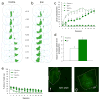Paradoxical accentuation of motivation following accumbens-pallidum disconnection
- PMID: 29408054
- PMCID: PMC5864546
- DOI: 10.1016/j.nlm.2018.02.001
Paradoxical accentuation of motivation following accumbens-pallidum disconnection
Abstract
The nucleus accumbens (NAc) and ventral pallidum (VP) are reciprocally connected, and activity within this circuit is thought to promote reward learning. Inconsistent with this notion, we find that disconnecting NAc medial shell and VP greatly enhances the attribution of value to a cue that is paired with reward. This result suggests that medial NAc shell and VP are both needed for attributing value to cues yet can also oppose one-another's functional contribution.
Keywords: Nucleus accumbens; Sign-tracking; Ventral pallidum.
Copyright © 2018 Elsevier Inc. All rights reserved.
Conflict of interest statement
Figures



Similar articles
-
Ventral pallidum encodes relative reward value earlier and more robustly than nucleus accumbens.Nat Commun. 2018 Oct 19;9(1):4350. doi: 10.1038/s41467-018-06849-z. Nat Commun. 2018. PMID: 30341305 Free PMC article.
-
Circuit directionality for motivation: Lateral accumbens-pallidum, but not pallidum-accumbens, connections regulate motivational attraction to reward cues.Neurobiol Learn Mem. 2019 Jul;162:23-35. doi: 10.1016/j.nlm.2019.05.001. Epub 2019 May 13. Neurobiol Learn Mem. 2019. PMID: 31096040 Free PMC article.
-
Ventral Pallidum Neurons Encode Incentive Value and Promote Cue-Elicited Instrumental Actions.Neuron. 2016 Jun 15;90(6):1165-1173. doi: 10.1016/j.neuron.2016.04.037. Epub 2016 May 26. Neuron. 2016. PMID: 27238868 Free PMC article.
-
The ventral pallidum: Subregion-specific functional anatomy and roles in motivated behaviors.Prog Neurobiol. 2015 Jul;130:29-70. doi: 10.1016/j.pneurobio.2015.03.005. Epub 2015 Apr 6. Prog Neurobiol. 2015. PMID: 25857550 Free PMC article. Review.
-
Ventral pallidal regulation of motivated behaviors and reinforcement.Front Neural Circuits. 2023 Feb 2;17:1086053. doi: 10.3389/fncir.2023.1086053. eCollection 2023. Front Neural Circuits. 2023. PMID: 36817646 Free PMC article. Review.
Cited by
-
Ventral pallidum encodes relative reward value earlier and more robustly than nucleus accumbens.Nat Commun. 2018 Oct 19;9(1):4350. doi: 10.1038/s41467-018-06849-z. Nat Commun. 2018. PMID: 30341305 Free PMC article.
-
'Liking' and 'wanting' in eating and food reward: Brain mechanisms and clinical implications.Physiol Behav. 2020 Dec 1;227:113152. doi: 10.1016/j.physbeh.2020.113152. Epub 2020 Aug 23. Physiol Behav. 2020. PMID: 32846152 Free PMC article. Review.
-
Sign-tracking behavior is sensitive to outcome devaluation in a devaluation context-dependent manner: implications for analyzing habitual behavior.Learn Mem. 2020 Mar 16;27(4):136-149. doi: 10.1101/lm.051144.119. Print 2020 Apr. Learn Mem. 2020. PMID: 32179656 Free PMC article.
-
Distinct role of nucleus accumbens D2-MSN projections to ventral pallidum in different phases of motivated behavior.Cell Rep. 2022 Feb 15;38(7):110380. doi: 10.1016/j.celrep.2022.110380. Cell Rep. 2022. PMID: 35172164 Free PMC article.
-
Circuit directionality for motivation: Lateral accumbens-pallidum, but not pallidum-accumbens, connections regulate motivational attraction to reward cues.Neurobiol Learn Mem. 2019 Jul;162:23-35. doi: 10.1016/j.nlm.2019.05.001. Epub 2019 May 13. Neurobiol Learn Mem. 2019. PMID: 31096040 Free PMC article.
References
-
- Berridge KC. Motivation concepts in behavioral neuroscience. Physiology & Behavior. 2004;81:179–209. - PubMed
Publication types
MeSH terms
Grants and funding
LinkOut - more resources
Full Text Sources
Other Literature Sources

